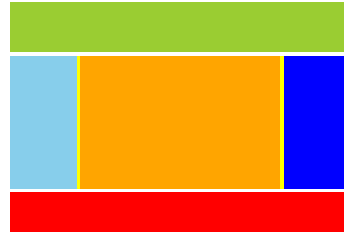浮动定位
浮动定位float
float可选值:
* none,默认值,元素默认在文档流中排列
* left,元素会立刻脱离文档流,向页面的左侧浮动
* right,元素会立刻脱离文档流,向页面的右侧浮动
浮动定位是居于文档流之上的定位。
<!DOCTYPE html>
<html>
<head>
<meta charset="{CHARSET}">
<title></title>
<style>
.box1{width:200px;
height:200px;
background-color: red;
float: left;
}
/*块元素在文档流中默认垂直排列,所以这个三个div自上至下依次排开
* 如果希望块元素在页面中水平排列,可以使用块元素脱离文档流
* 使用float设置元素浮动,从而脱离文档流
* 可选值:
* none,默认值,元素默认在文档流中排列
* left,元素会立刻脱离文档流,向页面的左侧浮动
* right,元素会立刻脱离文档流,向页面的右侧浮动
*
* 当为一个元素设置浮动以后会立刻脱离文档流,它下面的元素会立刻顶上来,元素浮动以后会尽量往左上或者往右上漂浮
* 浮动元素要比文档流更高一层
*
*/
.box2{width:300px;
height:300px;
background-color: yellow;
}
.box3{width:200px;
height:200px;
background-color: blue;
}
</style>
</head>
<body>
<div class="box1"></div>
<div class="box2"></div>
<div class="box3"></div>
</body>
</html>
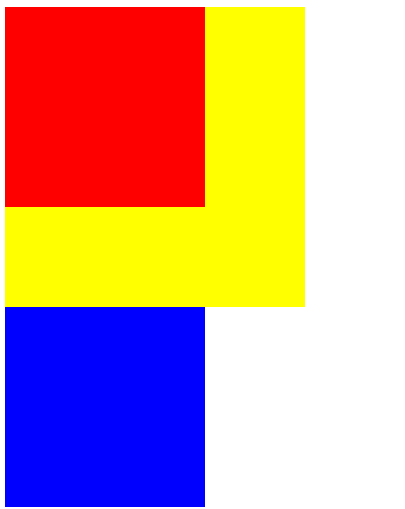
浮动定位不会超过上面的兄弟元素
<!DOCTYPE html>
<html>
<head>
<meta charset="{CHARSET}">
<title></title>
<style>
.box1{width:600px;
height:200px;
background-color: red;
float: left;
}
/*块元素在文档流中默认垂直排列,所以这个三个div自上至下依次排开
* 如果希望块元素在页面中水平排列,可以使用块元素脱离文档流
* 使用float设置元素浮动,从而脱离文档流
* 可选值:
* none,默认值,元素默认在文档流中排列
* left,元素会立刻脱离文档流,向页面的左侧浮动
* right,元素会立刻脱离文档流,向页面的右侧浮动
*
* 当为一个元素设置浮动以后会立刻脱离文档流,它下面的元素会立刻顶上来,元素浮动以后会尽量往左上或者往右上漂浮
* 浮动元素要比文档流更高一层
*
* 浮动元素上面是一个没有元素,它就不会超过块元素。
*
* 浮动的元素不会超过他上边的兄弟元素
*/
.box2{width:600px;
height:300px;
background-color: yellow;
float:left;
}
.box3{width:200px;
height:200px;
background-color: blue;
float:left;
}
</style>
</head>
<body>
<div class="box1"></div>
<div class="box2"></div>
<div class="box3"></div>
</body>
</html>
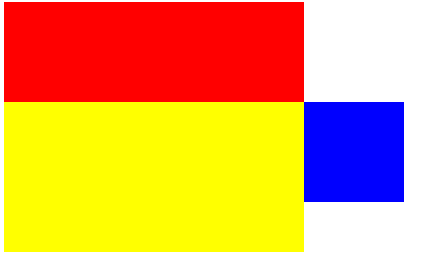
可以通过浮动设置文字环绕效果
<!DOCTYPE html>
<html>
<head>
<meta charset="utf-8" />
<title></title>
<style>
#box1{width:100px;
height:100px;
background-color: yellow;
float:left;}
.p1{height:50;
background-color: blue;
color: red;}
</style>
</head>
<body>
<div id="box1"></div>
<p class="p1">55551111111111111111111111111111111111
55555511111111111111111111111111111111111111111
111111111111111111111111111111111111111111111111
111111111111111111111111111111111111111111111111
111111111111111111111111111111111111111111111111
111111111111111111111111111111111111111111111111111
1111111111111111111111111111111111111111111111111111
111111111111111111111111111111111111111111111111111111
111111111111111111111111111111111111111111111111111111
1111111111111111111111111111111111111111111111111111</p>
</body>
</html>
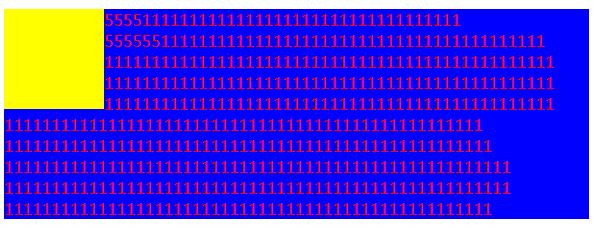
内联元素设置浮动就可以变成内连元素
<!DOCTYPE html>
<html>
<head>
<meta charset="utf-8" />
<title></title>
<style>
#box1{width:100px;
height:100px;
background-color: yellow;
float:left;}
.p1{/*内联元素脱离文档流会变成块元素*/
float: right;
height:100px;
width:100px;
background-color: blue;
color: red;
}
</style>
</head>
<body>
<div id="box1"></div>
<span class="p1">111</span>
</body>
</html>
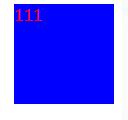
下面是一个简单的页面排版:
<!DOCTYPE html>
<html>
<head>
<meta charset="UTF-8">
<title></title>
<style>
*{padding: 0;
margin: 0;}
.header{width: 1000px;
height: 150px;
background-color: yellowgreen;
margin: 10px auto;}
.content{width: 1000px;
height: 400px;
background-color: yellow;
margin: 10px auto;
}
.left{width: 200px;
height: 400px;
background-color: skyblue;
float: left;}
.height{width: 600px;
height: 400px;
background-color: orange;
float: left;
margin: 0 10px;}
.bottom{width: 180px;
height: 400px;
background-color: blue;
float: left;
}
.footer{width: 1000px;
height: 120px;
background-color: red;
margin: 10px auto;
}
</style>
</head>
<body>
<div class="header"></div>
<div class="content">
<div class="left"></div>
<div class="height"></div>
<div class="bottom"></div>
</div>
<div class="footer"></div>
</body>
</html>
